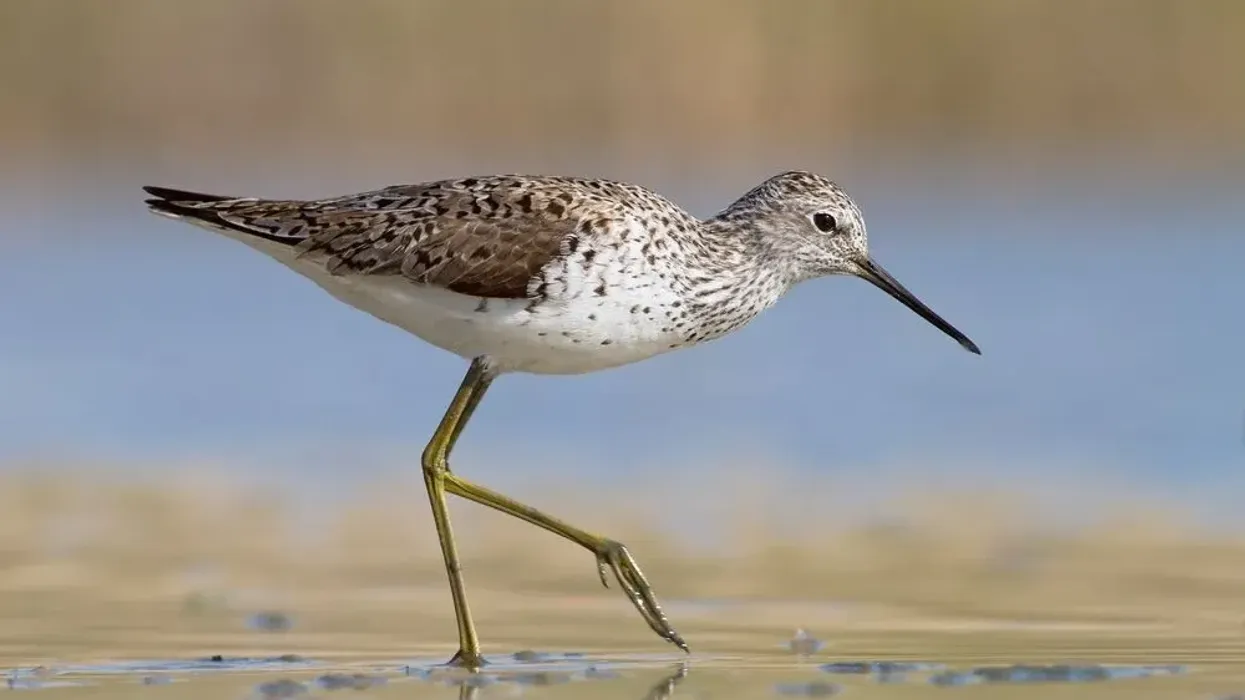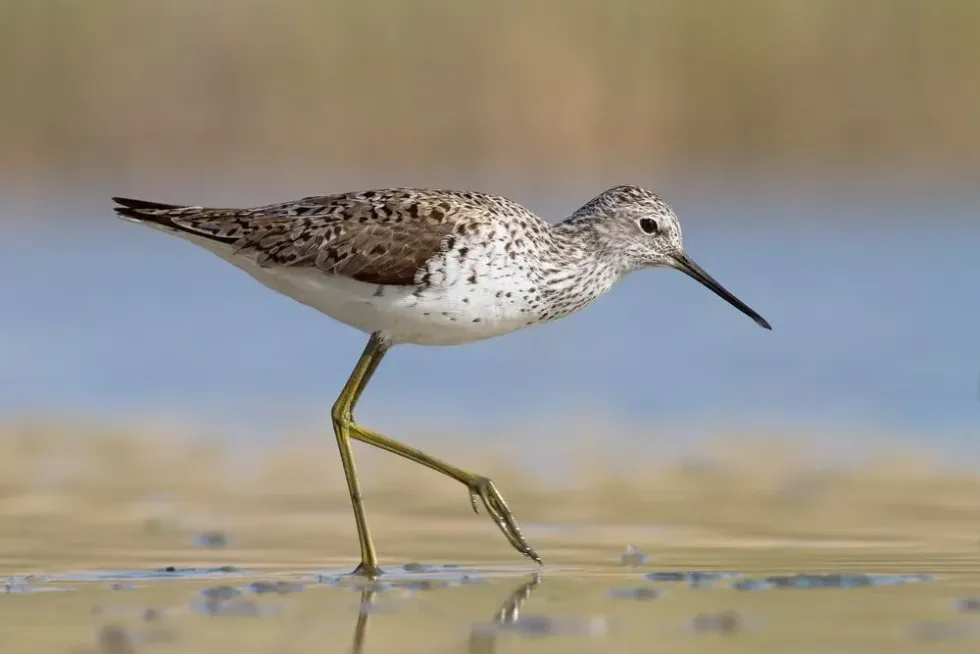The marsh sandpiper, Tringa stagnatilis as it is scientifically known, belongs to the family Scolopacidae. This bird also belongs to the Charadriiformes category of birds as it has often been spotted with a diverse flock of small to medium-large birds of the world.
The marsh sandpiper migrates throughout the year.
The marsh sandpiper prefers to live in the open grassy steppes or freshwater wetlands. These sandpipers are migratory birds and can be found in eastern Europe and Central Asia during one half of the year and in regions of Africa, India, and Australia during the other half of the year.
The vivid white wedge makes the marsh sandpiper identification process easier as it is such a distinct attribute. The throat and breast of these slender-bodied birds are a bright white color that helps in their identification.
The appetite of this species generally consists of tiny insects and invertebrates.
Since this species lives in moist mudflats and in marsh vegetations, they prefer to only eat what is available in these regions. The marsh sandpiper has a unique way of communicating through a call.
Keep on reading to learn more interesting facts about the bird. For more relatable content, check out these Australian pelican facts and Atlantic puffin facts for kids.
Marsh Sandpiper Interesting Facts
What type of animal is a marsh sandpiper?
The marsh sandpiper is a type of bird.
What class of animal does a marsh sandpiper belong to?
The marsh sandpiper is a bird that belongs to the class of Aves.
How many marsh sandpipers are there in the world?
The global population distribution of the marsh sandpiper (Tringa stagnatilis) has been estimated to be approximately between 260,000-1,200,000 across the globe.
Where does a marsh sandpiper live?
The marsh sandpiper prefers to live in open grassy steppes or freshwater wetlands. These birds are migratory birds and can be found in eastern Europe and Central Asia during one half of the year and in regions of Africa, India, and Australia during the other half of the year.
What is a marsh sandpiper's habitat?
The marsh sandpiper is known as a species that migration is a very important factor in order to find the best and most suitable ecological conditions and habitat for food and survival. Their migration takes place throughout the year.
In fact, the marsh sandpiper migrates continuously during all seasons and does not settle in one region. The distribution of this species of birds can be found in eastern Europe and Central Asia during one half of the year and in regions of Africa, India, and Australia during the other half of the year.
These birds are seen alone or in small to mid-sized flocks in their natural habitat.
The marsh sandpiper species nature habitat includes wetlands, shallow water lakes, rivers, streams, brackish lakes, and lagoons. These birds prefer eating small aquatic insects and worms.
Who do marsh sandpipers live with?
Marsh sandpipers can be seen living singly or in small to mid-sized flocks or groups. During the breeding season, these birds are seen in loose colonies amidst several other groups and various other birds of the world and birds of North America.
How long does a marsh sandpiper live?
The marsh sandpiper can live up to 12 years in its natural habitat.
How do they reproduce?
The marsh sandpiper (Tringa stagnatilis) breeds only in the marshland of eastern Europe, western Siberia, Mongolia, or North China as these regions have suitable breeding grounds for these birds. The breeding period ideally lasts from April to June in the majority of their breeding range.
These birds take flight from the breeding grounds from the end of June to early September during wintertime. The breeding process is pretty swift.
They prefer to breed solitarily or in loose colonies. After the process of breeding takes place, these birds create a nest that is a shallow depression on a mound at a marsh. The marsh sandpiper female typically lays two to five eggs in one single clutch a few weeks after they breed.
This clutch will contain the pale buff eggs. The marsh sandpiper egg is incubated by both the parents until the hatchlings arrive.
What is their conservation status?
The conservation status of these birds has been listed under the Least Concern category as they have been found in abundance in many parts of the world. Their population is quite stable.
Marsh Sandpiper Fun Facts
What do marsh sandpipers look like?
The marsh sandpiper (Tringa stagnatilis) is a small bird belonging to the family Scolopacidae, of wader or shorebirds measuring 7.9-9.8 in (20-25 cm) in length and weighing 1.4-4.2 oz (40-120 g) with a wingspan of 21.6-23.6 in (55-60 cm).
According to the marsh sandpiper's description, they have brownish-gray feathers on the upper half of their bodies including their head and neck, during summer and pale to almost soft gray plumage during winter.
The lower half of their bodies have a prominent white wedge. This vivid white wedge makes the marsh sandpiper's identification process easier as it is such a distinct attribute.
The throat and breast of these slender-bodied birds are a bright white color that helps in their identification. They have a dull plumage with a small yet prominent head, slender neck, fine back, and wings that have parallel streaks of dark brown and black.
The most prominent and noticeable feature of this species is the bill. The bill is long, sharp, and pointy.
It plays a very important role in wading. The bill is pinkish with shades of dark brown at the tip.
This species has dark and sharp blackish pupils. The marsh sandpiper's slender long green legs and a small tail are quite prominent features.
These green long legs can sometimes be pale yellowish-green depending on the region. It is because of their distinct colors that these birds look great in photos and images.

How cute are they?
This bird is considered to be pretty cute because of its long legs, fine body, and tiny tail.
How do they communicate?
This bird has a unique way of communicating through continuous calls. This sandpiper species call is considered to be melodious as their call resembles a 'tuee-u..tuee-u' sound.
How big is a marsh sandpiper?
The marsh sandpiper (Tringa stagnatilis) is a small bird, measuring 7.9-9.8 in (20-25 cm) in length and a wingspan of 21.6-23.6 in (55-60 cm). This bird is three times smaller than the Australian pelican and nearly nine times smaller than the Sarus crane.
How fast can a marsh sandpiper fly?
The exact speed of the flight of the marsh sandpiper has not been recorded but the marsh sandpiper wingspan is around 21.6-23.6 in (55-60 cm).
How much does a marsh sandpiper weigh?
The marsh sandpiper weighs about 1.4-4.2 oz (40-120 g).
What are the male and female names of the species?
Marsh sandpiper male or female birds do not have specific names. Their scientific name is Tringa stagnatilis.
What would you call a baby marsh sandpiper?
There is no specific name given to a marsh sandpiper baby, but in general, the little ones are called chicks.
What do they eat?
The appetite of this species generally consists of tiny insects and invertebrates. Since this species lives in moist mudflats and in marsh vegetations, they prefer to only eat what is available in these regions. They also eat several types of amphipods, insect larvae, flies, beetles, and dragonflies. Their diet also consists of seeds and marsh grass.
Are they dangerous?
It is known that the sandpiper marsh does not harm humans in any way but similar to other birds, these birds do not like interacting with humans.
Would they make a good pet?
This species of birds are not friendly with humans which is why they won't be good pets. Migration is an essential element in the lives of these birds. These sandpipers do not settle in one region and are not suitable to be petted.
Did you know...
Marsh sandpipers have been spotted in regions of North America especially during winter.
More than often you can spot a common greenshank with marsh sandpiper as these belong to the Charadriiformes category of birds and their description is quite similar. Bird-watchers often debate which bird is more interesting between the common greenshank vs marsh sandpiper.
The name 'sandpiper' comes from the bird's voice or call. This species is specifically called the marsh sandpiper as it belongs to marshy regions.
The marsh sandpiper is such an interesting bird that bird-watchers arrive in droves to see marsh sandpiper birds in Solano County in Asia and Europe. These bird-watchers love capturing images and photos of these beautiful birds.
Are marsh sandpipers endangered?
No, this species has been given the conservation status of Least Concern. However, a downward trend has been observed in the population range of this species due to a long history of habitat alteration, ecosystem modifications, pollution, and human intrusions.
What are marsh sandpipers known for?
This wading bird is known for its graceful nature and slender body which is unlike any other sandpiper bird in its family.
Here at Kidadl, we have carefully created lots of interesting family-friendly animal facts for everyone to discover! Learn more about some other birds from our green heron interesting facts and reddish egret fun facts pages.
You can even occupy yourself at home by coloring in one of our free printable stint bird coloring pages.









